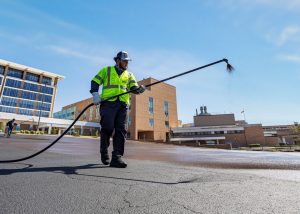Winter is coming. It may still be in the 80s and 90s in Texas but it’s definitely coming. For paving companies throughout the country, work begins to slow down as the temperatures drop. Luckily, here in Texas, our warm weather allows us to extend our paving season pretty far but that doesn’t mean we don’t need to prepare. Texas is used to extremes. From extreme heat to extreme ice, we’ve seen it all and so has our pavement. This extreme weather can exhaust your pavement, causing cracks, faded striping, and flaking which can then lead to bigger problems. As we slowly creep out of the hot weather, now is a great time to keep your eye on any potential damage that could lead to problems once we hit the rainy and icy season hit:
1. Inspect Your Pavement
Take the time to inspect your asphalt for any cracks, potholes, or signs of wear. Addressing these issues early can prevent them from worsening during the freeze-thaw cycles of winter. Look for:
- Cracks larger than 1/4 inch
- Potholes or depressions
- Surface flaking or traveling
Applying a sealcoat is one of the most effective ways to protect your asphalt from winter damage. Sealcoating helps to fill small cracks and provides a barrier against moisture. Ideally, you should sealcoat your asphalt every 3-5 years, depending on wear and exposure.
Before the winter weather sets in, it’s essential to fill any cracks and potholes. Use a quality asphalt patching compound for potholes and crack filler for smaller imperfections. This not only prevents water from seeping in and freezing but also reduces the risk of further damage caused by snow plows and traffic.
4. Keep Your Surface Clean
Regular cleaning is vital, especially before winter. Remove leaves, dirt, and debris from your pavement, as they can trap moisture and contribute to deterioration. Consider power washing to remove any oil stains or substances that could compromise the integrity of your asphalt.
Good drainage is crucial during winter. Check your drainage systems, such as gutters and storm drains, to ensure they are clear and functioning properly. Water that pools on your asphalt can freeze, leading to cracks and potholes. If you notice any drainage issues, address them promptly.
6. Schedule Professional Maintenance

While many tasks can be done DIY, enlisting a professional asphalt company for an inspection and maintenance before winter can save you time and money in the long run. Professionals can spot issues you might miss and recommend the best protective measures for your specific situation.
Winter can be tough on your asphalt, but with a little proactive care, you can extend its lifespan and maintain its appearance. By following these winterization tips, you’ll ensure that your pavement remains in great shape for years to come. If you have any questions or need assistance with your asphalt maintenance, don’t hesitate to reach out to our team—we’re here to help! Keep your pavement safe this winter!




